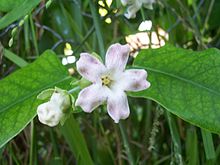- Araujia sericifera
-
Araujia sericifera Scientific classification Kingdom: Plantae (unranked): Angiosperms (unranked): Eudicots (unranked): Asterids Order: Gentianales Family: Apocynaceae Subfamily: Asclepiadoideae Genus: Araujia Species: A. sericifera Binomial name Araujia sericifera
Brot.- Araujia albens (Mart.) G.Don 1837.
- Araujia calycina Decne. 1844.
- Araujia grandiflora (Mart.) Morong Ann. 1893.
- Araujia hortorum E.Fourn. 1885.
- Araujia sericifera f. calycina (Decne.) Malme 1909.
- Araujia sericifera f. hortorum (E.Fourn.) Malme 1909.
- Araujia sericifera var. hortorum (E.Fourn.) Malme 1900.
- Physianthus albens Mart. 1824.[1]
Araujia sericifera is a perennial ornamental plant in the genus Araujia belonging to Apocynaceae family. This plant has been described in 1818 by the Portuguese botanist Félix Avelar Brotero. Its common names include , Moth Plant, White Bladderflower, Common Moth Vine and Cruel Vine.
Contents
Etymology
The genus name (Araujia) derives from António de Araújo e Azevedo, 1st Count of Barca (1754–1817), a portuguese amateur botanist who conducted scientific studies and experiments in his own botanical garden. The Latin name sericifera of the species, meaning silk-bearing, refers to the silky hairs surrounding the seeds inside the fruits.
Description
Araujia sericifera is a creeping vine that can climb up to 5–7 metres (16–23 ft) of height. If broken this plant releases a milky smelly exudate. Leaves are opposite, dark green, glossy and quite fleshy, almost triangular, with entire margins, about 10–12 millimetres (0.39–0.47 in) long.
The twining stems bear plenty of fragrant, chalice-shaped bisexual flowers, of about 2 centimetres (0.79 in) of diameter,with five white, creamish, violet or pale pink petals. The flowers are usually pollinated by moths (hence the common name of the plant), butterflies and bees (entomophily), but they are capable of automatic self-pollination. The flowering period extends from July through September. The pear-shaped fruits are large pods of about 8–10 centimetres (3.1–3.9 in) of length. They contain numerous black seeds surrounded by silky hairs which enable them to be dispersed by the wind.
The fast-growing vines can cover a tree canopy in two or three years, competing with the tree for light, water, and nutrients. They damage trees by this competition and by twining so tightly around their branches that it girdles them.[2]
Distribution
This plant native to South America was introduced in Europe and in many other countries as an ornamental plant, but it is now considered a noxious weed. Nowadays its geographical distribution includes southern Europe, south Africa, North America (California, Georgia), South America (Argentina, Brazil, Paraguay, Uruguay), Australia and New Zealand.[3]
Habitat
These plants grow in wastelands with trees and hedges, in forests and in rocky places or cliffs. They prefer sunny or partially shady places, at an altitude of 0–1,800 metres (0–5,900 ft) above sea level.
Gallery
References
- ^ Synonyms in wikispecies
- ^ CDFA EncycloWeedia.
- ^ Araujia sericifera - moth plant, Royal New Zealand Institute of Horticulture. Copied from Ian Popay, Paul Champion & Trevor James, An Illustrated Guide to Common Weeds of New Zealand. ISBN 0-473-09760-5.
- Syst. veg. 6:120. 1820 (R. Brown, Asclepiadeae 41. 1810; Mem. Wern. Nat. Hist. Soc. 1:52. 1811, nom. inval.)
- Tutin TG, Heywood VH, Burges NA, Moore DM, Valentine DH, Walters SM and Webb DA (1964/80) Flora Europeaea, Vol 1-5. Cambridge University Press, Cambridge (GB).
External links
Categories:- Apocynaceae
- Invasive plant species
- Invasive plant species in South Africa
Wikimedia Foundation. 2010.








